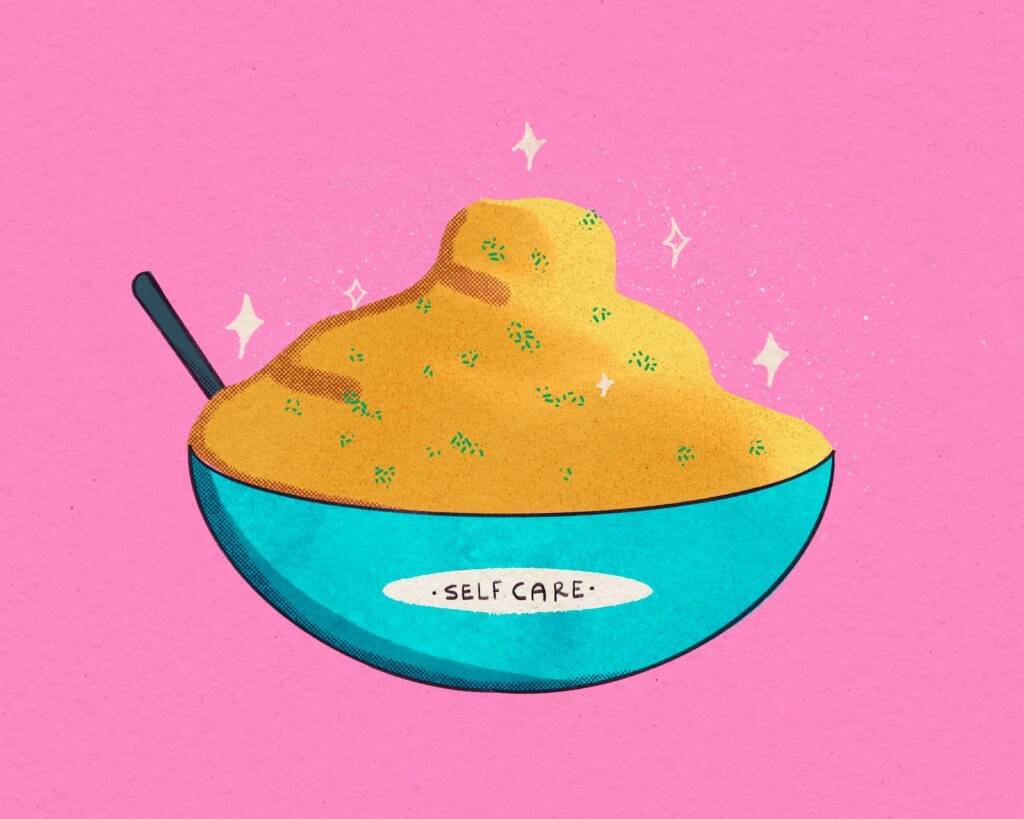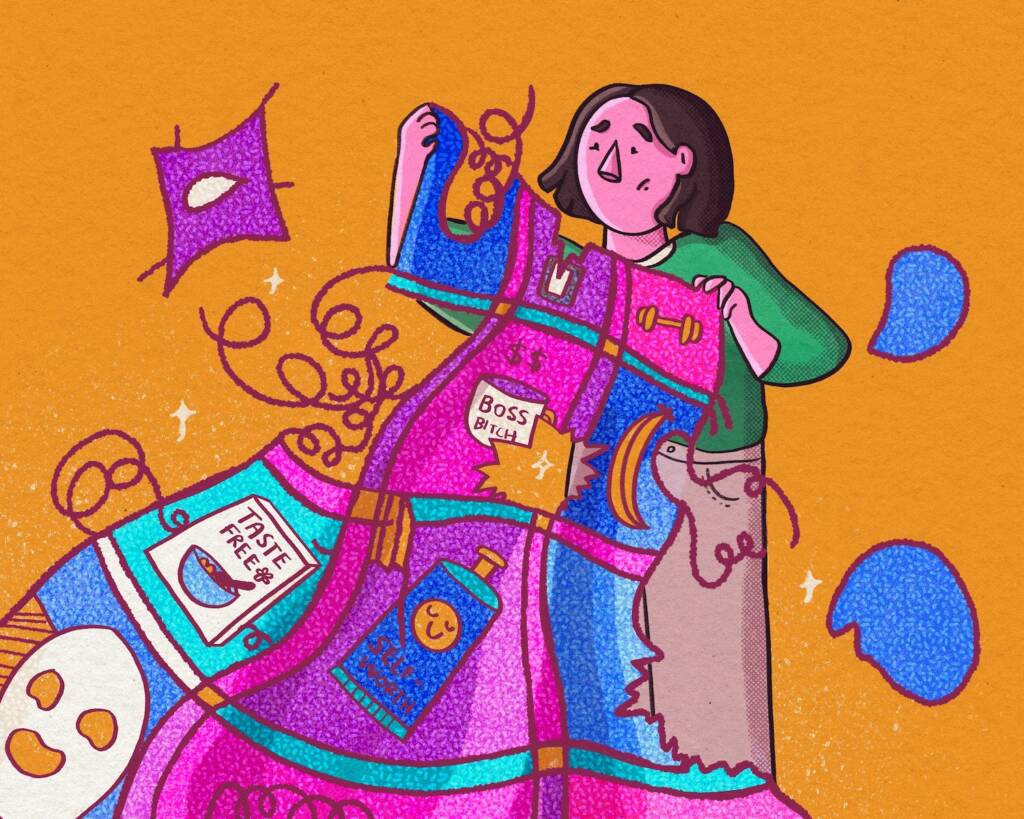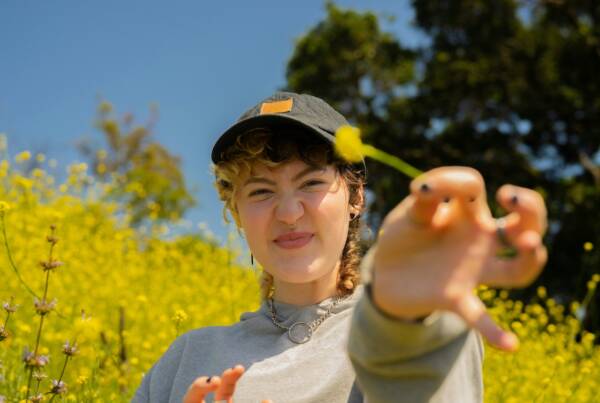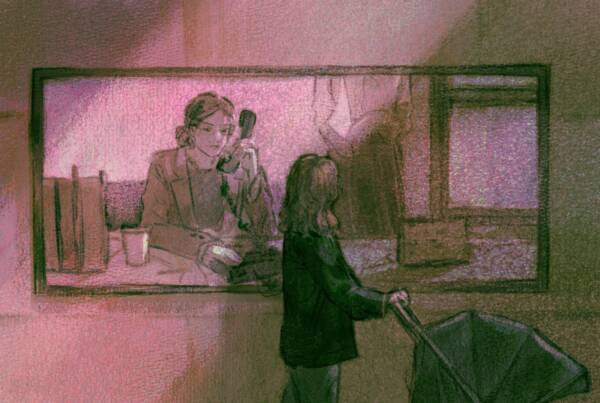Writing by Freya Robinson // illustration by Nea Valdivia
Despite the term ‘self care’ having spent the last decade being fired at the public consciousness with all the restraint of a club promoter with a t-shirt gun, few people seem to have a firm hold on it.
Depending who you’re talking to, self care can be interpreted as anything from going for a walk, to buying new shoes, to only eating liquified vegetables and getting divorced. At the same time, advertising campaigns rarely offer any more practical help than links to hotlines or lotion promising both self-worth and beautiful dripping-wet skin.
Our resources are not examining the linguistic goo of what it means to be ‘good’ or ‘nice’ to ourselves, which makes falling into self-indulgence or sacrifice all too easy. But vagueness around this subject wasn’t created solely as a marketing ploy for you to get your nails done – uncertainty over the subject does have a longer history than that.
When it first came to prominence in the 20th century, self care was a prescribed medical practice. The concept of caring for yourself and your community (and thus being less reliant on the state), however, was attractive to marginalised groups and caught wind as a radical political act during the civil rights movement. To complicate things further, all of this can be traced back to the 19th century Clean Living movement, which promoted wellness via bland cereal and anti masturbation campaigns. Suffice it to say, our ideas of what it means to be healthy and cared for are tangled up in differing notions of morality.
In the decades since, corporations have sifted the most marketable gems from all this and proliferated them at speed through suburban yoga classes and the internet. Combined, this has left self care with the structural integrity of mashed potato.
The worrying aspect is that this corporate-led approach has now become many people’s primary source of mental health care, whether in the form of therapy jargon whittled down into Tiktok-sized morsels, or bald gurus with protein shakes who think you can overcome any adversity by doing enough burpees – which is about as mentally beneficial as doing ayahuasca in a shed with a guy named Clive.
It’s unsurprising people are receptive to these things, though. A semblance of control and agency are tantalising prospects in a period of social and economic hardship. You can almost understand Gwenyth Paltrow putting eggs in her vagina if, even temporarily, it makes life feel less rocky and unpredictable.
The point is, everyone’s trying to tell you what self care is and isn’t – and now it’s my turn.
Because, despite the varied intentions behind this patchwork of self care, I do believe the concept is helpful. And while increased rates of ill-health, and lack of access to medical care are the result of systemic issues – which self care is not a solution to – understanding your body can ease mental strain.
At its most basic level, self care, to me, is: keeping yourself clean and fed, processing your emotions, and making decisions that are in your long-term best interests. There, end of article. Except! Doing this usually involves staring down the barrel of your worst personality traits, which is the emotional equivalent of stepping in dog poo (and also where many people draw the line).
Self care turning out to be a pain in the arse sounds contradictory, but then so does the phrase butterfly knife, and just like being able to spin a series of blades around your palm, being honest with yourself about your needs is scary, cool, and makes people want to date you.
What’s very important to remember, though, is to go slow – we don’t want you slicing your fingers off in the process. Refrains like ‘rise and grind’ and ‘do the work’ might have you picturing yourself completing fragments of self care in the style of a Rocky training montage, until one day you reach the summit, wiser and more profound. Unfortunately the vagus nerve has other ideas.
Initially, this approach seems possible. You could get up early, delete all your social media, and live exclusively off a series of complex carbs. Similarly, many apprentice magicians believe they could complete the tablecloth trick without breaking all their mother’s antique kitchenware. Start with the card tricks.
Taking away all your coping mechanisms at once puts huge strain on your body, and will likely end in a freak out where you dive-bomb into the stingray pool and get banned from the aquarium. Or something.
The upshot is, you cannot punish yourself into health, or grit your teeth into becoming a better person. Believe me, I have tried and failed at this enough times to know that you’d have about as much luck trying to eat yoghurt with chopsticks. I would say it’s impossible, but I’ve seen videos of people that can pull a freight train with their earlobes, so you never know. However long you can carry it off, though, it’s unlikely you’ll be happier.
Because while exercise, a regular sleep schedule and a balanced diet are all pretty neat, in the wrong circumstances they can be useless. If your body is exhausted, or overwhelmed, sometimes you need a lie in, or to sit in your pyjamas all day and eat a family pack of Monster Munch.
The flip side of this is that you can’t constantly let yourself off the hook – lobbing your CBT diary into oncoming traffic and only having a shower or eating a vegetable when you feel compelled to do so, is equally bananas. As counterintuitive as it may sound, occasionally doing things that make you feel uncomfortable is a healthy part of a life.
“This is too complicated now.”
You’re telling me! Take it up with whoever invented the nervous system.
“So what on earth do I do? Where is this sacred balance between putting my feet up and plunging into my darkest traumas?”
Well, it turns out drinking-awareness campaigns were right: know your limits. And to do that you have to begin the process of getting to know yourself, so you can recognise when you’re pushing yourself to do everything at once, and when you’re avoiding things that scare you by not doing anything at all.
For the things that need to be done (e.g basic hygiene, clear communication), find the time and place that make these easiest for you. For everything else, it’s a case of if and when. Figure out what feels good in your body. Only you can do this (sorry!) although the internet is full of handy tips and tricks such as grounding techniques, journaling prompts and reasonably-priced meditation apps.
I know for a lot of people, doing things they know are good for them doesn’t feel physically good. Which is why, to check if your bod is being a sneaky deceptive liar, you check in afterwards as well.
It’s also why trial and error is really important. I know sometimes we’d all rather put on rubber gloves filled with custard than admit to a mistake, but realising when things don’t work is the only way you’re going to learn what does.
Of course, this is very join-the-dots. Emotions are more complex than that and it’s likely you’ll slip-n’-slide along the scale of doing too much or too little, but you will get better at realising when you’ve gone too far and begin reining it in.
You will change, life will change and the best you can do is pay attention. We should put down our aims of ‘achieving wellness’ – as Jiddu Krishnamurti says, ‘It is no measure of health to be well adjusted to a profoundly sick society.’, but that also makes it all the more important we find ways to look after ourselves.








